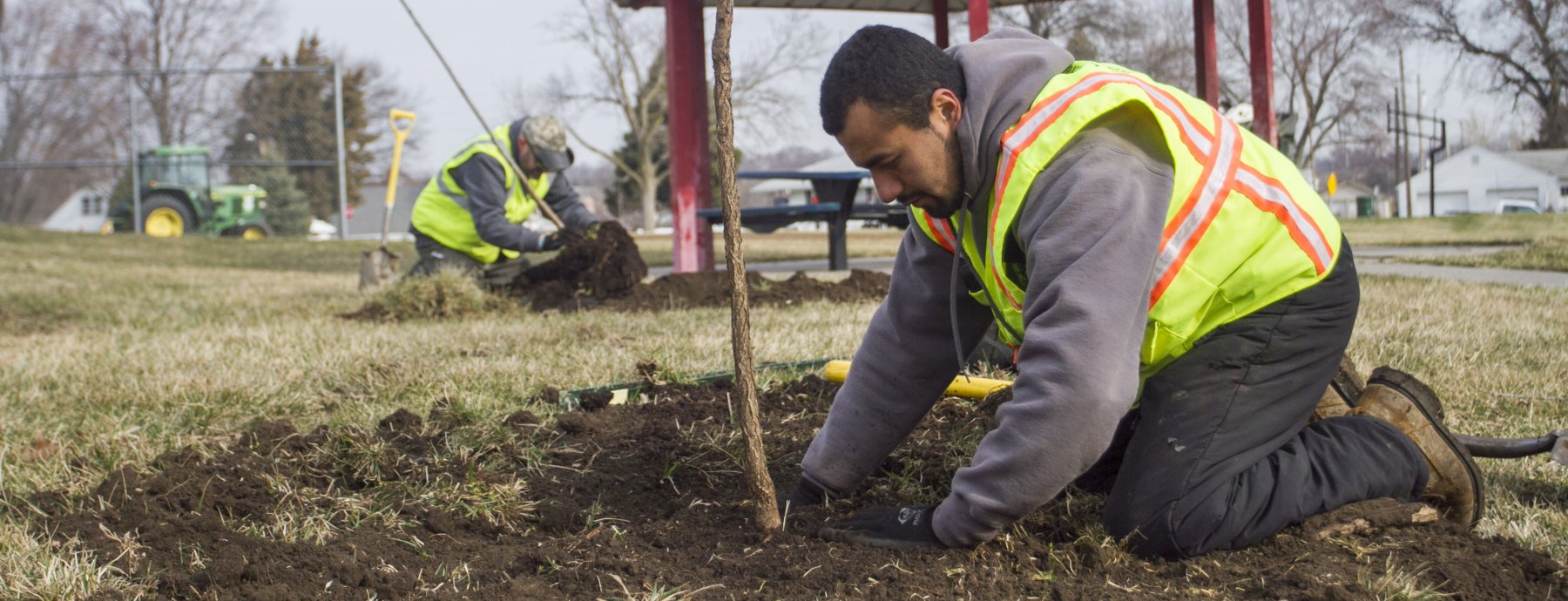Digging
Dig a saucer-shaped hole wider than the root system but no deeper than the root mass. Most holes do not need to be deeper than about one shovel’s depth (10-14”). The bottom of the hole should be firm enough to prevent the tree from settling deeper after planting.
Using an auger is not recommended since trees often settle too deep and the sides of the holes become glazed. If using an auger, don’t drill deeper than needed and loosen the sides of the hole. Remember, always call before you dig. (Photo courtesy: Arbor Day Foundation).
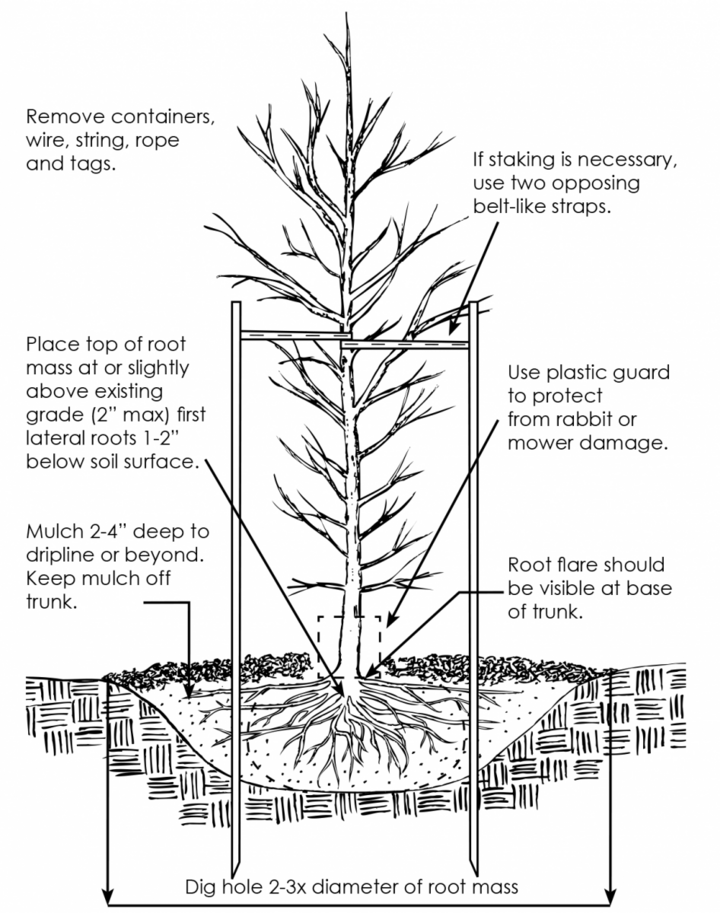
Planting
Plant the tree so the base of the trunk is at the original ground level or slightly higher. The first lateral roots should end up just under the soil surface (1-2” deep) and the trunk should "flare" visibly at ground level. Always locate the first main lateral roots and remove any excess soil above them before setting the plant in the hole.
The first main roots are often several inches below the top of the container or root ball. All graft unions should be visible above the soil line. Remove all pots and containers before planting. For balled and burlap (B&B) stock, try to remove the wire basket and burlap before placing the tree in the hole.
If maintaining the integrity of the soil ball is important, then remove the bottom part of the burlap and wire basket before setting the plant in the hole and then remove the remaining burlap and wire basket after stabilizing the tree in the hole. Remember to check for and remove any excess soil at the top of the root ball before planting. Loosen and spread circling roots before backfilling (especially important for potted trees).
It may be necessary to cut larger roots that cannot be straightened to prevent girdling, but this should be done with caution. Reject plants with severely circled or girdled root systems. For potted trees, try to remove as much of the original growing medium as possible before planting to help achieve good soil-root contact. Dunking in water or spraying with a hose will help in this effort.
Follow Chancellor Green's lead! Note how the soil of the potted tree is level with the surrounding area.
Backfilling
Backfill with the original soil dug from the hole. Large clods and soil chunks should be broken up as much as possible. You want to be sure you're eliminating large air pockets when filling the hole. Lightly tamping your shovel handle around the tree helps. If you have a water source, some folks prefer adding water during backfilling to remove these pockets. It also moistens the roots.
Mulching
Mulch individual trees with a 2-4” layer of wood mulch extending from the trunk to at least the drip line of the tree (the furtherest extent that branches reach). Where possible, mulch trees and other plantings together to help separate from the surrounding turf.
Don’t pile the mulch deeply over roots or against the base of the trunk and don’t mulch with rock or use plastic weed barriers under the mulch. Mulch breaks down over time so reapplying over a few seasons is not a bad idea.
Mulch helps retain moisture, but it also helps guide lawn mowers away from the base of the tree. We call this incidental damage "mower's blight."
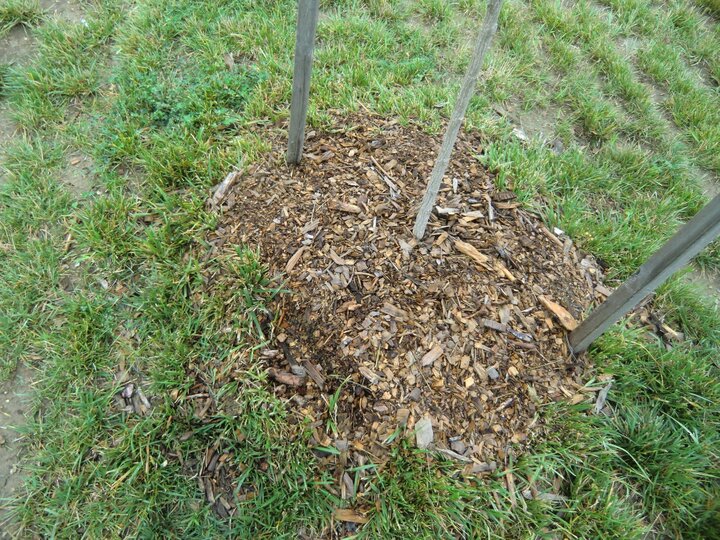
Staking & Bracing
There is not a whole lot to know about staking with a few exceptions. The design, if you will, is only limited to your imagination. Your biggest concern is bracing the sides of the tree that experience seasonal winds.
The materials that make contact with the tree are less forgiving. Any material that can rub against the bark of the tree can cause damage. The more rigid or abrasive, the worse off your tree will be. For this reason, we recommend things like rubber, denim, or fabric straps. Please, please do not use wire.
Drive your stakes on the sides of the tree that face seasonal winds (normally, the west and north). Line them up so they make a somewhat straight line (don't worry about exactness here). Secure one end of your guying material to the stake and wrap the other end around the main stem of the tree. Allow for some sway when tightening. Where exactly this wrap occurs depends on the height of the tree. Don't overthink it, just make sure it feels secure. Return the loose end of the material to your stake and tie a knot. You can reuse these materials so use a knot that's easy to untie.
The trick with all plantings is to get it done right the first time so the tree can establish a deep, sprawling root system. Most trees typically benefit from staking, anyway. Remove all the materials within one year.
Rubber, denim, and fabric straps are all great bracing materials.
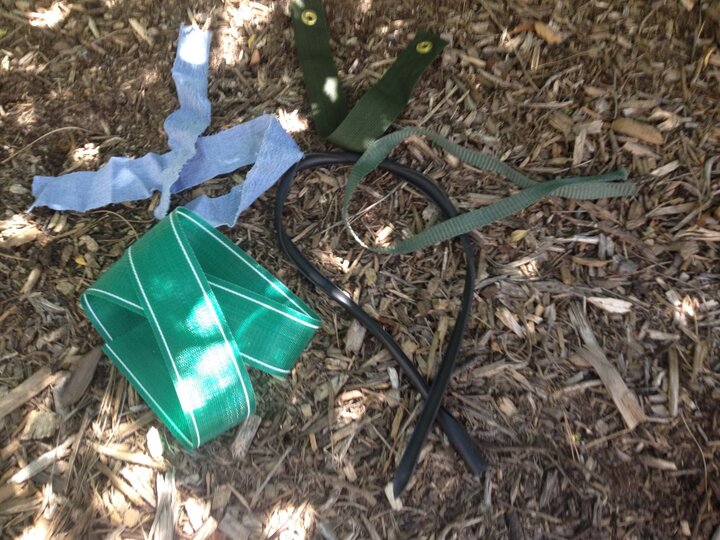
Watering
After planting, keep the root zone moist but not waterlogged. In general, a newly planted tree should receive about 1” of moisture per week, including rainwater, during the first growing season. Check the root zone frequently for moistness—don’t just guess. Many trees are lost to either under- or over-watering. Containerized trees often need more watering than bare-root or B&B stock, because the porous growing medium they are potted in dries out faster.
Note how the soil settles during watering. This is referred to as "watering it in." This eliminates air pockets and helps the tree settle into place. Additional soil should be added to make sure no roots become exposed.
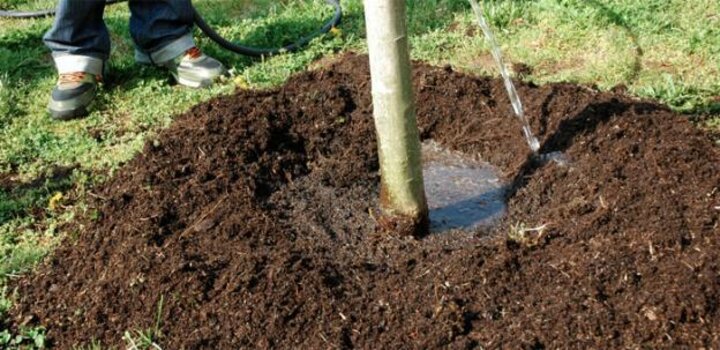
Fertilizing
If the right tree was selected for the planting site, fertilizer is generally not needed. If fertilizer is desired, use only a slow-release, low-nitrogen fertilizer applied to the soil surface after planting. Never add fertilizer to the planting hole since it can damage newly transplanted roots. In addition, excess nitrogen in the soil can cause newly planted trees to add top growth at the expense of proper root development. Address major soil problems before planting. Adding organic matter to the planting site before planting can be very beneficial for poor, inorganic and/or compacted soils.
Pruning
At planting time, prune only to remove dead or damaged branches and to correct structural defects. Never cut back healthy branches or trim the tree to try and “balance” the top with the roots. The tree will benefit from having as many food-producing leaves left on as possible. Also, try to leave lower branches on a tree for as long as possible after planting. Lower branches help protect the trunk from cracking, sunscald and animal damage and they aid in developing good trunk taper. If needed, limb the tree up gradually over a matter of several years after planting. Monitor the tree when young and prune, sparingly but properly, to prevent structural defects. Read more about pruning here.
